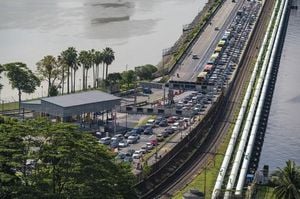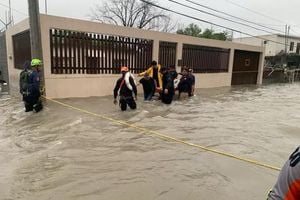On Saturday, March 22, 2025, cycling aficionados flocked to Liguria for the prestigious Milano-Sanremo and the much-anticipated return of the Sanremo Women race, a significant milestone for women's cycling.
The Milano-Sanremo race for professionals caused major modifications in local traffic, with temporary circulation suspensions in effect at least 30 minutes before the racers passed through critical areas along the route. According to the official cronotabella, the fastest average speed was noted around 1:45 PM, meaning the last speeding vehicles would have likely cleared the routes before the anticipated crowds.
Some key streets affected included Via Ovada, Via Lemerle, and the Aurelia SS1 towards Ponente. Parking restrictions were imposed from 7 AM until 5 PM, preventing any vehicles from stopping in designated zones along the marathon routes.
The event also featured the Sanremo Women race, marking a return after a two-decade hiatus, welcoming top female cyclists from around the world back to this classic competition. With the race went a flood of changes to accommodate activities happening throughout the day, including total bans on stopping and transit in places like Piazza della Vittoria, effective from midnight to 3 PM.
The Sunday event is not just about cycling; it's a celebration of equality within the sport. The Sanremo Women race is firmly part of the UCI Women's WorldTour underlining the commitment to inclusion in cycling. This thrilling race attracts 24 teams, including formidable names like world champion Lotte Kopecky and past champions such as Elisa Longo Borghini and Demi Vollering. The course stretches 156 kilometers starting at 10:35 AM in Piazza della Vittoria and covers elite climbs such as Cipressa and Poggio.
As both races unfold, tensions on the course escalate—the women's race saw its first major crash as Francesca Barale from Picnic PostNL suffered a fall while the pack sped toward the first climbs. The intensity was palpable as the leading cyclists approached the Capo Mele, a 1.8 km ascent at a steep 3.6%, resulting in changes among the group dynamics.
Meanwhile, a breakaway group formed early in the race led by Anne Knijnenburg, demonstrating the strategic maneuvering common in high-stakes cycling. With a growing lead of 2 minutes and 15 seconds over the peloton, Knijnenburg signaled the fierce competition that each participant faced. Reports indicated that conditions favored racers with drying roads, enhancing the experience compared to anticipated rain.
The return of the Sanremo Women, formerly known as Primavera Rosa, underscores the shift towards parity in cycling. Previously canceled in 2006, this event showcases women's efforts in ways that directly echo the historical milestones of their male counterparts. Yet, the prize disparities remain a stark reminder of the ongoing struggle for equality in sports, as the first-place winner of the men's classic secures 20,000 euros compared to just 2,256 euros awarded to the women’s victor.
Kirsty Coventry's recent election as president of the CIO further complements these advancements as the sports world sees more representation for women. The disparity in prize money amplifies the concerns of many advocates calling for equal rewards in all competition levels—a challenge that the Union Cycliste Internationale (UCI) continues to address amid growing cries for fairness.
Participants trod not just upon pavements but also upon principles of equality, and as the races unfolded, all eyes were locked in on the legendary Via Roma, where the final stretch towards the finish line would require every ounce of determination from these elite athletes.
With the Sanremo Women returning after 20 years, the atmosphere is charged with excitement and nostalgia as both men and women cyclists represent their countries on the same historic route that has long defined cycling excellence. Ultimately, this day not only celebrates the age-old competition but also serves as a critical declaration supporting women's progression within the sport and beyond.








